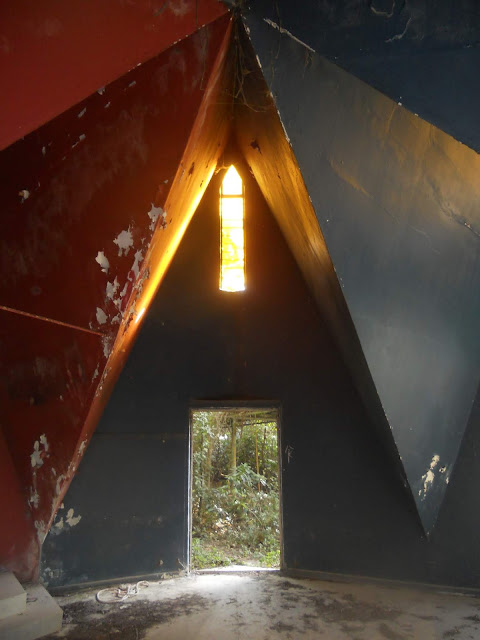Naturally, I was keen to see for myself, but Paula told me that because the access path is overgrown, there are a lot of mosquitoes, so it seemed sensible to wait until it was too cold for these annoying little pests before taking a look. Last Friday, it was too cold for both cycling and mosquitoes, so I asked Paula to show me the temple.
I frequently cycle along Po Kak Tsai Road, and as with everywhere else, I looked down side roads and paths to see whether they led anywhere. Sometimes I would have to go down the road or path, but in this case, there didn’t seem any point:
This photo was taken when I visited the site, but it was a much more obvious dead end when I first passed this way. The figure in the distance here is emerging from a colossal building site, where a large number of high-rise residential blocks are being built. From the architectural style, these blocks appear to be intended for public housing.
And there is a path at the end of the original road:
The next photo shows the continuation of the path to the right of the temporary construction barrier seen in the previous photo:
The way is straight ahead:
It follows the fence line enclosing the building site and is both steep and treacherous underfoot (loose grit):
I found it necessary to hold onto the fence most of the time!
…and it continues upwards for quite some distance:
This, finally, was my first view of the temple:
It may seem from this photo that it’s a simple rectangular structure with a steeply pitched roof, but the actual floor plan is hexagonal, with doors on five sides. There is also a narrow, pointed window above each doorway:
…and there is a six-pointed star inset into the floor of the temple:
The next photo shows a raised platform on the side of the hexagon without a door:
It once housed the temple’s altar (the red wall/ceiling on this side of the temple is immediately suggestive).
Any means of access to the temple when it was still in use has now been reclaimed by the jungle, so, having seen everything there is to see, we proceeded to descend the steep access path, hanging onto the fence at every step.
However, between the second and third photos above, a concrete ‘road’ leads off to the left:
We couldn’t head off home without seeing to where it might lead! The twisted barrier on the left implies that this might have once been an entrance to whatever lies within, and there is still a security fence out of sight to the left.
We eventually came across three odd buildings, the purpose of which we could only guess:
Our guess is that they were once used to house animals, but they seemed much too small for those animals to have been horses.
And, despite its bizarre appearance, there is absolutely nothing that you can see now that identifies the temple as a religious building. However, there is a plaque next to the first doorway that provides some useful history. It was built in the 1960s (in reinforced concrete) for the benefit of the Gurkha regiment that was stationed here, because what I’ve described here is all that remains of the British Army base known as Burma Lines (formerly Queen’s Hill Camp).
The temple’s shape is intended to mimic that of the lotus, which represents beauty and holiness in Hinduism. The temple was dedicated to Shiva, the Hindu god of destruction, which somehow seems appropriate, given the nature of its patrons. I have only one personal experience of these hard-as-nails warriors. In the early 1980s, I used to take part in orienteering competitions organized jointly by the police and army. I can still recall a complaint by the then commandant of the Police Cadet Training School:
The [expletive] Gurkhas are running in straight lines again [on a compass bearing]!I’d learned years ago that however tempting an apparent shortcut, you should stick to the paths because you would be ripped to shreds by the undergrowth. The Gurkhas never did. And they won every competition!
The temple has been accorded Grade 3 preservation status. The entire base was abandoned by the British Army in 1996, which may explain why it was never occupied by the PLA following the 1997 handover.
other posts in this series
Hidden History #2.
Hidden History #3.
Hidden History #4.
Hidden History #5.
Hidden History #6















Wonder how it will be like when the nearby residential area is eventually completed
ReplyDeleteSomewhere for the local kids to play?
Delete